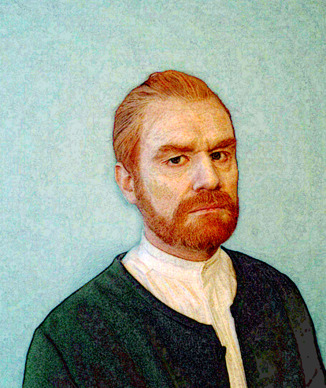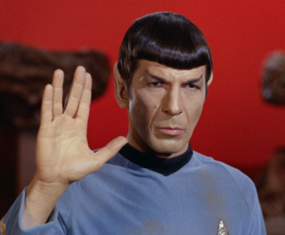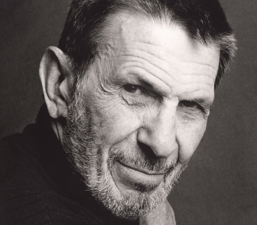Sommar 2016: Vincent
Under hela sitt konstnärliga liv var Vincent van Gogh ekonomiskt beroende av sin lillebror Theo. Detta skapade en relation fylld av motstridiga känslor, och tack vare att Vincent under alla dessa år skrev brev till sin bror får vi en inblick i hur en av världens främsta konstnärer levde sitt liv.
Föreställningen Vincent är en berättelse om skapande, tro och tvivel. Om försakelser och uppoffringar, glädje och sorg. Och kärlek.
Skådespelaren Fredrik Gunnarson som står på scen, har själv bearbetat och översatt Nimoys text. För ljus och scenbild står Carina Persson.
Fakta: Leonard Simon Nimoy, född 26 mars 1931 i Boston, Massachusetts, död 27 februari 2015 i Los Angeles, Kalifornien, var en amerikansk skådespelare, regissör, författare, musiker och fotograf. Han var framförallt känd för rollen som Spock i TV-serien Star Trek.
Nimoy var son till judiska immigranter från Ukraina. Hans far arbetade som barberare. Leonard Nimoy hade ett förflutet inom armén och innan han slog igenom som skådespelare arbetade han bland annat som taxichaufför och som dramalärare i Kalifornien, dit han flyttade 1955.
År 1966 fick han rollen som Spock i Star Trek vilket kom att bli hans mest uppmärksammade roll. Nimoy var med och utvecklade rollfiguren och låg bland annat bakom den välkända vulkanska hälsningen, som baserades på en del ur en judisk ceremoni.
Han medverkade även i flera filmer som handlade om förintelsen och judendom. 1973 debuterade han som regissör och har bland annat regisserat komedin Tre män och en baby (1987) samt två Star Trek-filmer; Star Trek III (1984) och Star Trek IV – Resan hem (1986). Nimoy gav ut två självbiografier, I Am Not Spock (Jag är inte Spock) (1975) och I Am Spock (Jag är Spock) (1995), flera fotoböcker och flera musikalbum. I egenskap av författare och fotograf intresserade han sig företrädesvis för reformjudendomen och kabbala.
År 2014 diagnostiserades Leonard Nimoy med lungsjukdomen KOL och den 27 februari 2015 avled han av sjukdomen. (Källa: Wikipedia)
How it began (Leonard Nimoy):
Some years ago I was a very active lecturer on the college circuit. The work was hard, travelling every day for two or three weeks, usually taking at least two planes and sometimes even three to make connections to the smaller towns like Billings, Montana. But the pay was an important part of my income and, at least for a while, the events were exhilarating.
Star Trek was enormously popular on the college campuses and students were eager to hear stories about the making of the original series. But inevitably, I felt repetitive and, as is my nature, I began searching for a new challenge. My hope was that I could develop a one-person show that would employ my acting skills while providing spiritual nourishment.
In the midst of one of my lecture tours I found the seed of the idea for Vincent. At a small college in upstate New York, I had just completed one of my appearances and was invited by a couple who were faculty members to come to their home for conversation and drinks. My usual pattern was to avoid those gatherings. They often amounted to a draining of energy at the end of a long day of travel and work. Then there would be a night of restless sleep in a new motel room and an early flight in the morning. But somehow these people seemed sympathetic and interesting and I accepted their invitation.
It was a good evening of conversation. We talked about politics, academia and the arts. I asked them to tell me what other speakers had been on the circuit. Usually, I recognized the names of my fellow travelers, book authors and politicians who were most frequently mentioned, but in this case there was a new and intriguing presentation. An actor had done an evening portraying Theo, Vincent's brother, in a play called Van Gogh written by Phillip Stephens.
There was a treasure to draw from. Vincent Van Gogh had written over 500 letters to his brother Theo over the 10 year period of Vincent's struggle to master his art. Theo was Vincent's total support, financially and emotionally and Vincent's letters, now widely published, were as passionate as his paintings. Both in spiritual and artistic statement, they described Vincent's progress in his life and his art.
In a short time I was able to contact Phillip Stephens and bought the rights to his play. I felt indebted to him for the idea, which made the evening viable for me, namely that I would portray Theo and give the audience this special vision of the great painter as seen through his brother's eyes. We worked out a contract whereby some scenes were kept intact, but essentially I set out to develop a new play titled Vincent. In my research, I found a letter that Theo had written to his mother after Vincent's death. The mother was ill and unable to travel so Theo described the funeral and told his mother that while others spoke at the service, he himself was too overcome with grief and was unable to express himself. From this I built the idea that Theo was now wanting to say some things about his brother and had invited this audience to come and hear his story.
After three tryout performances, I was invited to present the play at the Guthrie Theater in Minneapolis, one of the most esteemed regional theaters in the country. I was extremely well received by audience and critics and subsequently toured 35 cities giving 150 performances as a Guthrie Theater presentation. Eventually the show was taped at the Guthrie for the A & E television network and is still available through Paramount Home Video.
It is a great source of pleasure to know that Vincent lives through the performances of talented actors, and most recently the video version has been accepted into the archives of the educational division of the Van Gogh Museum in Amsterdam. (Källa: Wikipedia)
Kommentera gärna:
Senaste inläggen
Senaste kommentarer
-
Gunilla Widholm » Sommar 2023: Förställning: ”Tack Fredrik Gunnarsson för en fantastisk föreställning! Jag blir lycklig över a..”
-
Emeli » Sommar 2023: Förställning: ”Hej! Från vilken ålder rekommenderar ni föreställningen? Mvh Emeli ”
-
Ingmar Nilsson » Sommar 2018: Don´t worry be happy: ”Kommer gärna när spelplanen är klar.”
-
Lars Bengtsson » Sommar 2017: Mathissen: ”Hej! Bjärnums stadsteater, tredje sOmmaren i rad, vilket har blivit en trevlig t..”






